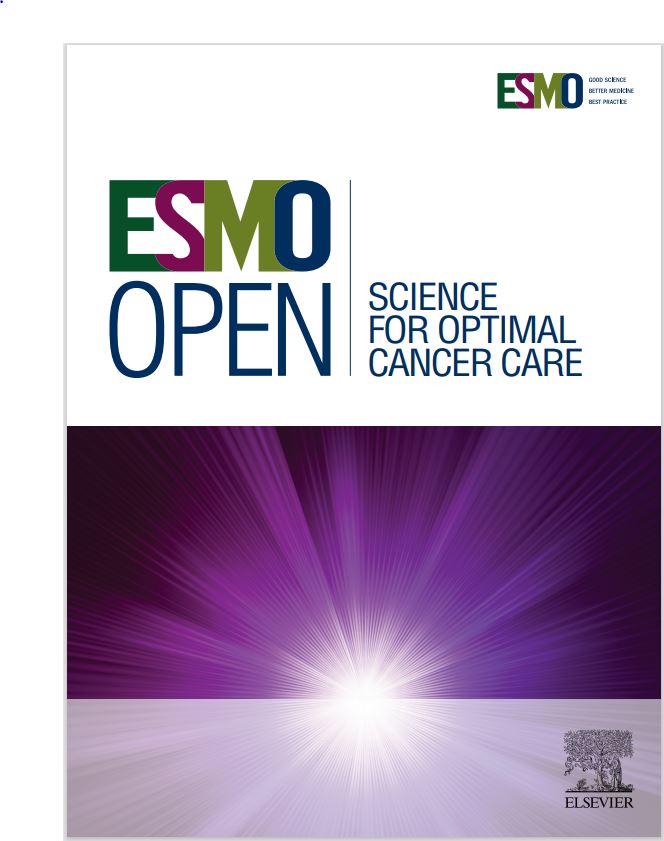伊瑞布林治疗BRAF V600E突变性转移性结直肠癌的多中心II期研究:courage研究(EPOC1701)
IF 8.3
2区 医学
Q1 ONCOLOGY
引用次数: 0
摘要
基于已有报道的微管抑制剂在BRAF V600E突变型结直肠癌异种移植模型中的抗肿瘤作用,本多中心II期研究旨在评估伊立布林对BRAF V600E突变型转移性结直肠癌(mCRC)患者的疗效和安全性。患者和方法BRAF V600E突变mCRC患者接受至少一种先前方案的静脉注射伊立布林。主要终点为客观缓解率(ORR)。使用肿瘤和系列血液样本进行生物标志物分析。将肿瘤缩小和/或无进展生存期(PFS)达到6个月的患者分为良好反应组,其余患者分为不良反应组。结果入选的27例患者,ORR为0%(95%可信区间0.0% ~ 12.8%),疾病控制率为41%,中位PFS为1.4个月,中位生存时间为5.3个月(中位随访为5.3个月)。在26例可获得肿瘤RNA测序的患者中,在BM亚型基因表达分析中,良好反应组的4例患者均为BRAF突变体(BM)2亚型,而不良反应组的22例患者为BM1 (n = 8)或BM2 (n = 14)亚型(P = 0.07)。在第二周期开始时BRAF V600E相对克隆性下降的患者比例在良好反应组和不良反应组分别为75%和11% (P = 0.02)。3级和4级不良事件包括中性粒细胞减少(63%)和发热性中性粒细胞减少(22%)。结论伊立布林治疗BRAF V600E突变型mCRC患者的II期研究未达到主要终点。虽然BM2对BM亚型基因表达的分析可能是伊瑞布林疗效的预测标志物,但需要进一步的研究来验证这一假设。本文章由计算机程序翻译,如有差异,请以英文原文为准。
A multicenter phase II study of eribulin for BRAF V600E mutant metastatic colorectal cancer: the BRAVERY study (EPOC1701)
Background
Based on the reported antitumor effects of microtubule inhibitors in xenograft models of BRAF V600E mutant colorectal cancer, this multicenter phase II study aimed to evaluate the efficacy and safety of eribulin in patients with BRAF V600E mutant metastatic colorectal cancer (mCRC).
Patients and methods
Patients with BRAF V600E mutant mCRC who received at least one prior regimen were administered intravenous eribulin. The primary endpoint was the objective response rate (ORR). Biomarker analyses were carried out using tumor and serial blood samples. Patients with reduced tumor size and/or progression-free survival (PFS) of >6 months were classified into the good response group, and the remaining patients were classified into the poor response group.
Results
Among the 27 patients enrolled, the ORR was 0% (95% confidence interval 0.0% to 12.8%), the disease control rate was 41%, the median PFS was 1.4 months, and the median survival time was 5.3 months (median follow-up, 5.3 months). Of 26 patients for whom tumors for RNA sequencing were available, all four patients in the good response group had the BRAF mutant (BM)2 subtype on gene expression analysis of BM subtype, whereas 22 patients in the poor response group had the BM1 (n = 8) or BM2 (n = 14) subtypes (P = 0.07). The proportion of patients with decreasing BRAF V600E relative clonality at the start of the second cycle was 75% and 11% in the good response and poor response groups, respectively (P = 0.02). Grade 3 and 4 adverse events included neutropenia (63%) and febrile neutropenia (22%).
Conclusions
This phase II study of eribulin for patients with BRAF V600E mutant mCRC did not meet the primary endpoint. Although BM2 on gene expression analysis of BM subtype may be a predictive marker of eribulin efficacy, further studies are required to validate this hypothesis.
求助全文
通过发布文献求助,成功后即可免费获取论文全文。
去求助
来源期刊

ESMO Open
Medicine-Oncology
CiteScore
11.70
自引率
2.70%
发文量
255
审稿时长
10 weeks
期刊介绍:
ESMO Open is the online-only, open access journal of the European Society for Medical Oncology (ESMO). It is a peer-reviewed publication dedicated to sharing high-quality medical research and educational materials from various fields of oncology. The journal specifically focuses on showcasing innovative clinical and translational cancer research.
ESMO Open aims to publish a wide range of research articles covering all aspects of oncology, including experimental studies, translational research, diagnostic advancements, and therapeutic approaches. The content of the journal includes original research articles, insightful reviews, thought-provoking editorials, and correspondence. Moreover, the journal warmly welcomes the submission of phase I trials and meta-analyses. It also showcases reviews from significant ESMO conferences and meetings, as well as publishes important position statements on behalf of ESMO.
Overall, ESMO Open offers a platform for scientists, clinicians, and researchers in the field of oncology to share their valuable insights and contribute to advancing the understanding and treatment of cancer. The journal serves as a source of up-to-date information and fosters collaboration within the oncology community.
 求助内容:
求助内容: 应助结果提醒方式:
应助结果提醒方式:


